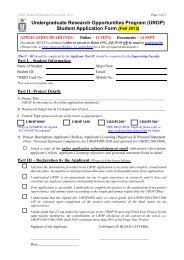UROP Proceedings 2010-11
UROP Proceedings 2010-11
UROP Proceedings 2010-11
You also want an ePaper? Increase the reach of your titles
YUMPU automatically turns print PDFs into web optimized ePapers that Google loves.
Innovative Iron-based Process for Odor Control in Storm Water Drain inTidal AreasAdvisor : SHANG Chii / CIVLStudent : SU Qida / CIVL(<strong>UROP</strong>1000, Summer 20<strong>11</strong>)Odor nuisance from box culverts has long been recognized by the public as a problem inHong Kong. Organic matters, tidal seawater and sulfate-reducing bacteria are the three factorswhich cause odor nuisance. Using chemical oxidants such as oxygen, chlorine and ferric saltsare useful for suppressing the odor; however, some of these chemicals are toxic, expensive,and may have low solubility in water and high energy requirement. Therefore, an innovative,low-cost and long-lasting granular iron-based technology is needed to resolve the odornuisance. The objective of this study is to develop a technology using granular ferrichydroxide (GFH) for sulfide control. In detail, it needs to be proved that GFH can helpremove the sulfide in sediment and can be reused.Set-up Effect of Displacement Pile in SandAdvisor : WANG Yu-Hsing / CIVLStudent : LI Ngan Fei / CIVL(<strong>UROP</strong>1000, Summer 20<strong>11</strong>)The capacity of displacement piles in sand has been found to increase with time elapsed sincethe end of driving. Such an increase in pile capacity is known as pile setup and is not due tothe dissipation of excess pore water pressure induced by pile installation. Similar findings arereported around the world. However, this extra pile capacity, which may lead to significantsavings in construction cost and time, has not been taken into account in the pile designbecause there is still no conclusion for the associated underlying mechanisms. In order tohave a better understanding about the cause of pile setup, further investigations are carried outin this study. This study begins with a comprehensive literature review and then proposes anexperiment using the techniques of tomography images to characterize the process of pilesetup.The Application of Time-lapse Resistivity Mapping: Soil ResistivityChanges with Water ContentAdvisor : WANG Yu-Hsing / CIVLStudent : LI Wu / CIVL(<strong>UROP</strong>1000, Summer 20<strong>11</strong>)Slope stability issues are intimately related to how the water front saturates the slope soil andthen decreases the associated effective stress (strength) at the sliding surface. Since the soilresistivity is significantly affected by the water content, the time-lapse resistivity mapping onslope can be an effective technique to monitor the associated water front movement along aslope. The capacitively-coupled resistivity meter, OhmMapper, is used for such a purpose inthis study. The preliminary testing results on a natural slope have proved the feasibility of thismethodology. Distinct differences in the resistivity mapping on the slope can be measuredbefore and after a rainfall event.33



